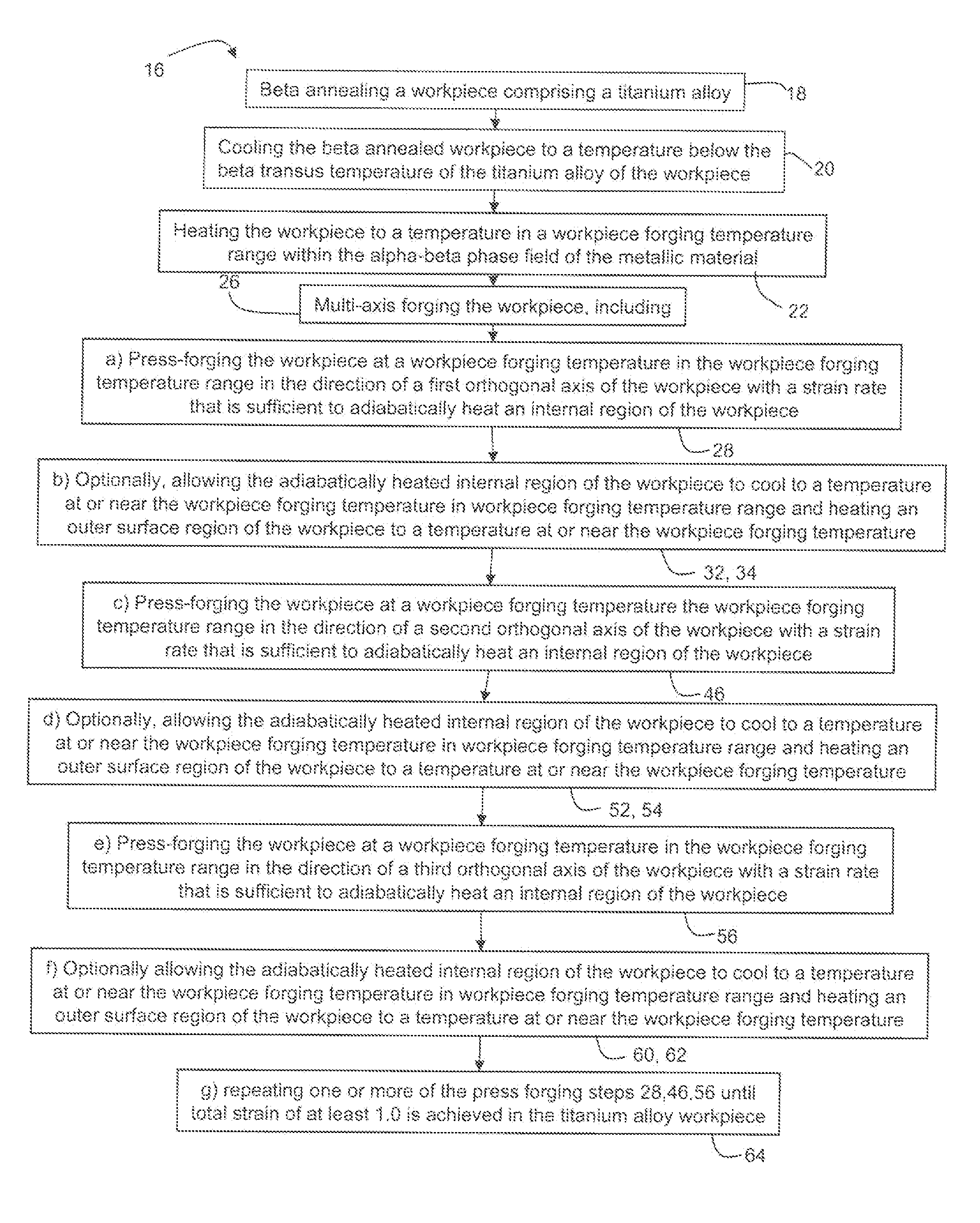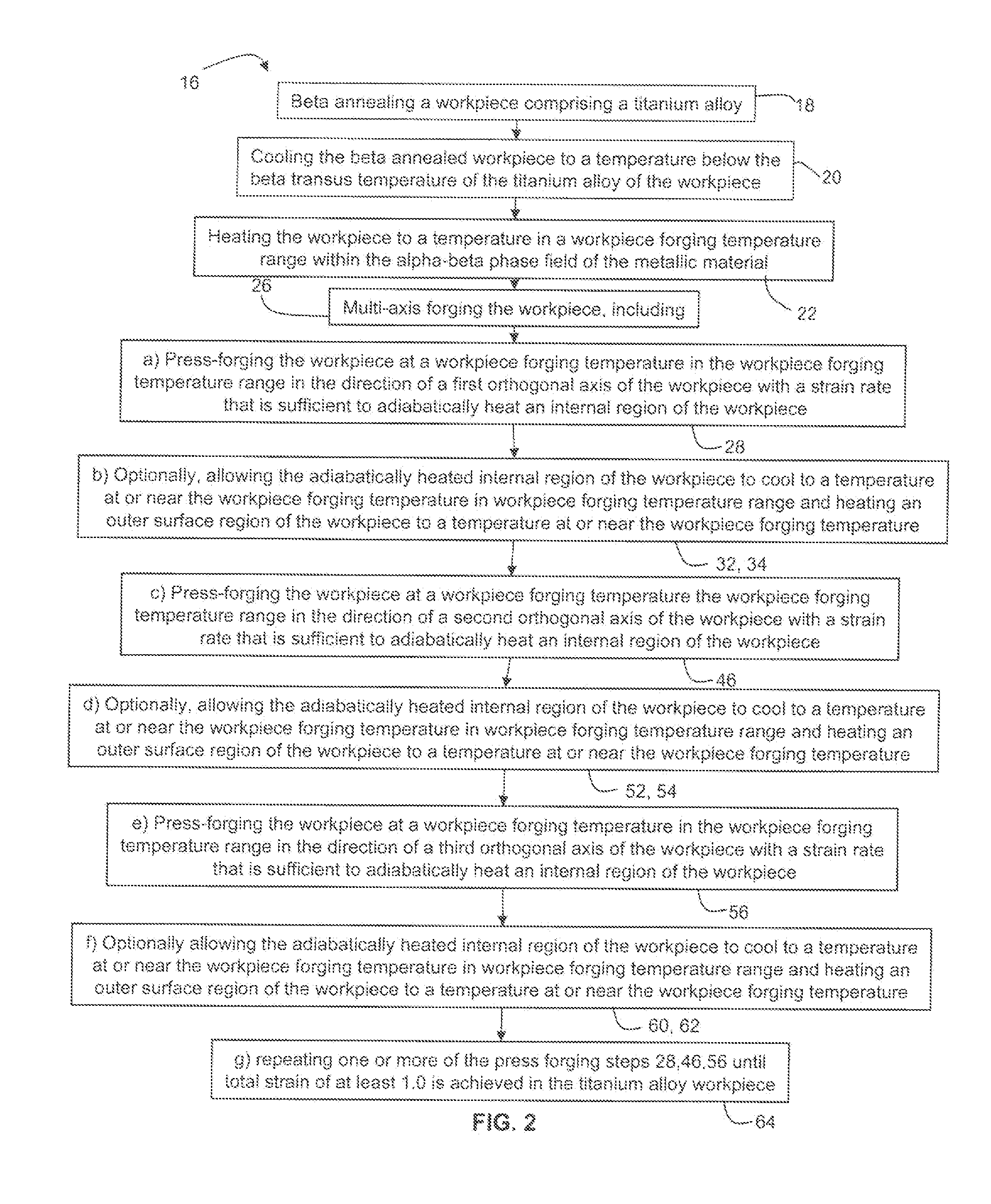Methods for processing titanium alloys
a technology of titanium alloys and titanium alloys, which is applied in the direction of manufacturing tools, forging/pressing/hammering apparatus, heating/cooling devices, etc., can solve the problems that the available open die press forging equipment may not have the capability to achieve ultra-slow strain rates, and the cumulative time taken to perform maf steps can be excessive in a commercial setting
- Summary
- Abstract
- Description
- Claims
- Application Information
AI Technical Summary
Benefits of technology
Problems solved by technology
Method used
Image
Examples
example 1
[0156]A bar of Ti-6-2-4-2 alloy was processed according to a commercial forging process, identified in the industry by specification number AMS 4976, which is typically used to process Ti-6-2-4-2 alloy. By reference to the AMS 4976 specification, those having ordinary skill understand the specifics of the process to achieve the mechanical properties and microstructure set out in that the specification. After processing, the alloy was metallographically prepared and the microstructure was evaluated microscopically. As shown in the micrograph, of the prepared alloy included as FIG. 11(a), the microstructure includes alpha grains (the lighter colored regions in the image) that are on the order of 20 μm or larger.
[0157]According to a non-limiting embodiment within the present disclosure, a 4.0 inch cube-shaped workpiece of Ti-6-2-4-2 alloy was beta annealed at 1950° F. (1066° C.) for 1 hour and then air cooled to ambient temperature. After cooling, the beta annealed cube-shaped workpiec...
example 2
[0158]A bar of Ti-6-2-4-8 alloy was processed according to a commercial forging process typically used for T-6-2-4-6 alloy, i.e., according to specification AMS 4981. By reference to the AMS 4981 specification, those having ordinary skill understand the specifics of the process to achieve the mechanical properties and microstructure set out in that the specification. After processing, the alloy was metallographically prepared and the microstructure was evaluated microscopically. As shown in the micrograph of the prepared alloy shown in FIG. 12(a), the microstructure exhibits alpha grains (the lighter colored regions) that are on the order of 10 μm or larger.
[0159]In a non-limiting embodiment according to the present disclosure, a 4.0 inch cube-shaped workpiece of Ti-6-2-4-6 alloy was beta annealed at 1870° F. (1066° C.) for 1 hour and then air cooled. After cooling, the beta annealed cube-shaped workpiece was heated to a workpiece forging temperature of 150° F. (815.6° C.) and forge...
example 3
[0160]In a non-limiting embodiment according to the present disclosure, a 4.0 inch cube-shaped workpiece of Ti-6-2-4-6 alloy was beta annealed at 1870° F. (1066° C.) for 1 hour and then air cooled. After cooling, the beta annealed cube-shaped workpiece was heated to a workpiece forging temperature of 1500° F. (815.6° C.) and forged using three hits of high strain rate MAF, one each on the A, the B, and the C axes (i.e., the hits were to the following orthogonal axes and in the following sequence: A-B-C). The hits were to a spacer height of 3.25 inches, and the ram speed was 1 inch per second. There was no strain rate control on the press, but for the 4.6 inch cubes, this ram speed results in a minimum strain rate during pressing of 0.25 s−1. The time between successive hits was about 15 seconds. After the A-B-C cycle of hits, the workpiece was reheated to 1500° F. (815.6° C.) for 30 minutes. The cube was then high strain rate MAF with one hit each on the A, the 8, and the C axes, i....
PUM
| Property | Measurement | Unit |
|---|---|---|
| Grain size | aaaaa | aaaaa |
| Temperature | aaaaa | aaaaa |
| Temperature | aaaaa | aaaaa |
Abstract
Description
Claims
Application Information
 Login to View More
Login to View More - R&D
- Intellectual Property
- Life Sciences
- Materials
- Tech Scout
- Unparalleled Data Quality
- Higher Quality Content
- 60% Fewer Hallucinations
Browse by: Latest US Patents, China's latest patents, Technical Efficacy Thesaurus, Application Domain, Technology Topic, Popular Technical Reports.
© 2025 PatSnap. All rights reserved.Legal|Privacy policy|Modern Slavery Act Transparency Statement|Sitemap|About US| Contact US: help@patsnap.com



